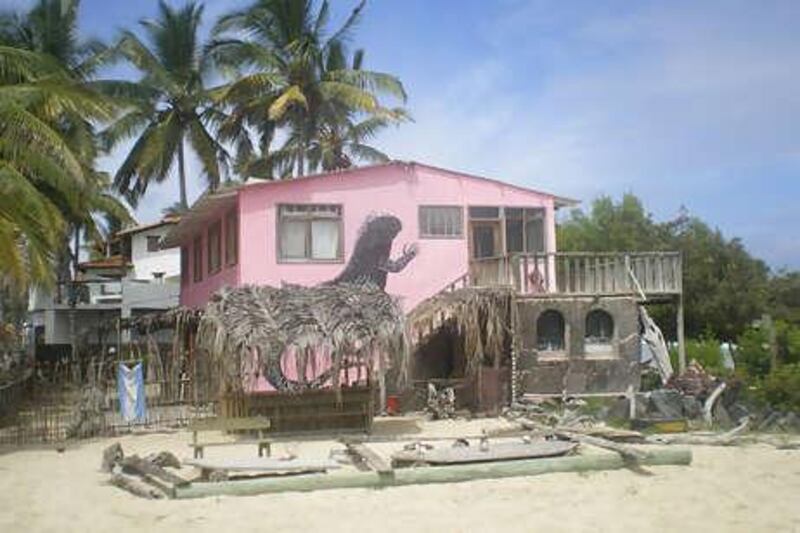I seem to have gate-crashed a family party. Mum and dad are hugging and getting a little over-excited, rolling around and biting each other's ears. The two young ones are playing about, rushing towards me then veering off to the side at the last moment. Each time I think they're bound to hit me, but they seem to know what they're doing. This is no ordinary family, though: these are Galapagos sea lions and I'm snorkelling with them.
I've only been a day in the Galapagos and already I'm daydreaming about giving it all up and joining a sea lion colony. After all, it's not a bad life, lounging around on rocks, swimming with the pups and catching fish. The sea lions' welcoming attitude to my presence is exactly what makes a trip to the Galapagos so incredible. While most animals in the wild are scared or at best suspicious of humans, the reaction on the Galapagos ranges from curiosity to playfulness, the legacy of no natural predators on the islands (aside from the Galapagos hawk for trivia buffs). I decided quickly that the sea lions were my particular favourite and took every opportunity I could over the next week to swim with them.
Charles Darwin developed his theory of evolution after travelling to the Galápagos in the 1830s, and the wildlife of these islands has changed the way we humans view ourselves. Visitors could be forgiven for wishing humans had evolved with eyes in the back of our heads, such is the array of wildlife - there are some 50 endemic species of birds, reptiles and mammals. From giant tortoises to marine iguanas, sea lions to sharks and blue-footed boobies to magnificent frigatebirds, it's hard to know which way to turn on these unworldly volcanic islands, about 960 kilometres west of the Ecuadorian coast.
Returning to the port of Baquerizo Moreno on San Cristobal, I was told that Leon Dormido (sleeping lion) offered some of the best snorkelling in the Galapagos, so that's where I headed next. The remains of a lava cone, these two imposing rocks rise up to 150m, with a small channel between them through which we were to snorkel. As we peered into the dark waters, the guide told us this was a prime location for sharks. He assured us the white-tipped reef sharks and the hammerheads were harmless, so I swallowed my trepidation and dived in. They were initially nowhere to be seen, but then the guide banged his fists together underwater and, suddenly, dark shapes began rising. Soon I was surrounded by a dozen reef sharks, opening and closing their mouths mechanically. I couldn't see any teeth and they looked too small to be threatening, but the squeals of a 10-year-old girl close by told a different story.
As impressive as the sharks was a school of stingrays flapping their wings like underwater birds. I swam above them but kept my distance, mindful of the barbed sting which can whip up. Back on the boat, the scuba divers were enthusing about the hammerhead sharks they had seen farther down. The Galapagos is possibly the world's greatest diving destination, but I was content with snorkelling. The next day, I took a morning ferry to Santa Cruz, the most populous island. I headed to the Charles Darwin Research Station, the highlight of which is the walk-in giant tortoise enclosure where you can meet the creatures that gave the islands their name - "galápago" is an old Spanish word for a saddle similar to the shape of their shells. The station has 11 sub-species including famous Lonesome George, the last survivor from Pinta island. Three species are already extinct but there is a successful rearing programme to release tortoises back into the wild.
Next was the tiny island of North Seymour, which offers the best chance to sight blue-footed boobies. These birds take the prize for the most entertaining mating ritual. The male lifts his feet up, struts about raising his beak, emits a loud whistle and opens his wings as if to say: "How can you resist my bright blue feet?" The bluer the better for the female, who honks if she likes what she sees. The boobies were unfairly named "bobos" (stupid) by Spanish sailors who mistook their curious stares for a lack of intelligence. On land, you can get extremely close and the birds will peer at you without fear. They are no chumps, though, being extremely skilled at fishing, dive-bombing the sea from as high as 24m.
Another attraction on Seymour Norte are the frigatebirds, who also have a fantastic mating ritual. The males construct nests and inflate red skin flaps on their chests to the size of a football to attract females. Frigates can't swim, so they scavenge food from other birds and are often seen following fishing boats, hoping for a free meal. A visit to the Galapagos is enjoyable, challenging and even life-changing, but the islands' popularity certainly has its downside. Human presence has done huge damage to the fragile ecosystem. The worst example is the decimation of the giant tortoise population, at 250,000 before humans' arrival and now just 25,000, with three of the 14 original sub-species hunted into extinction. Other species are threatened with a similar fate: the flightless cormorant and mockingbirds are both endangered, affected by the introduction of dogs, cats and rats that eat the young. Water pollution is another key problem; Santa Cruz, in particular, has a deteriorating sewage problem from the expansion of hotels and housing. Offshore, poor quality petrol and careless driving from fishermen has damaged coral reefs. Add to these problems the high levels of illegal immigration, road traffic killing wildlife and illegal fishing, and it's little wonder that the Galapagos were placed on Unesco's danger list in April 2007.
Rafael Correa's left-wing government, in conjunction with the Galapagos National Park, has taken strong action recently, forcibly deporting thousands of illegal residents and temporary workers to the mainland, exterminating 250,000 goats (one of the most damaging invasive species) and launching a plan to use 100-per-cent renewable energy by 2017. Satellite technology is used to track illegal fishermen and there are tighter regulations on fishing. Nevertheless, fishing boats are regularly caught in the marine reserve.
Economic incentives have now persuaded many local fishermen to abandon illegal trade in favour of tourist excursions, which pay better for less work. Tourism is now essential to the islands, although visitor numbers have fallen for the first time - from 160,000 in 2007 to 145,000 in 2009 - it's unlikely they will fall further. However, the Ecuadorian government's action to date has succeeded in persuading Unesco to take the islands off the danger list, which they did in July this year. Environmentalists warn, however, that we are still far from a situation of truly sustainable development on the Galapagos.
Tourists can only see a tiny part of the islands, with 97 per cent of the area off limits. The 70 registered visitor sites comprise only 0.01 per cent of the land mass, a comforting fact for environmentalists. Half of the land mass is found on the largest island, Isabela, which I visited last. Its biggest draw is the dramatic landscape with six active volcanoes. The best excursion is Sierra Negra, the second largest crater in the world after Tanzania's Ngora-Ngora. The trek to the sulphur mines takes seven hours in total. As I found myself soaked to the skin by rain, my boots deep in mud, I wondered if it was worth it. However, the effort was soon rewarded with spectacular views of the crater followed by a descent into the yellow hills of the sulphur mines, which spew out pungent fumes. On the way back we encountered a tiny illegal immigrant: a field mouse. It was clearly well adjusted to the island attitude, as it sat on the path completely unconcerned by the group of hikers and started climbing over our boots. Even the mice on the Galapagos are friendly, the guide joked.
After my long hike, I headed back to the port, in dire need of a cold drink. I knew exactly where to go: La Casa Rosada. This beachside hotel is owned by the American Jeff Frazier and, if there were a competition for the coolest man in the world, Jeff would surely make the shortlist. A lawyer who has fought for the rights of indigenous people in the Ecuadorian jungle, he lives on Isabela with his wife and three children, dividing his time between running his hotel, recording albums with his band The Iguanamen and taking on the odd legal case.
"I have a colony of iguanas on my porch and 4,000 miles of ocean in front of me all the way to French Polynesia ," he muses. Jeff is considering opening a recording studio on the Galapagos and is looking for partners to invest. As I sit on the beach strumming a guitar, the idea of staying here for the rest of my life, making music and snorkelling with sea lions, sound very tempting.





